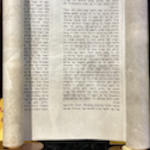
The final chapter in the Gospel of Mary begins with brothers Andrew and Peter rejecting what Mary has told them.
“In response Andrew said to the brothers (and sisters), ‘Say what you will about what she’s said, I myself don’t believe that the Savior said these things, because these teachings seem like different ideas.” In response, Peter spoke out with the same concerns. He asked them concerning the Savior: “He didn’t speak with a woman without our knowledge and not publicly with us, did he? Will we turn around and all listen to her? Did he prefer her to us?”
Interestingly, the Gospel of Mary includes the voices of those who reject its message because “these teachings seem like different ideas” than what we read from the other gospels, and that the source of these teachings is a woman. There is no attempt to hide the fact that what Jesus says here is different than the canonical gospel accounts.
In the Gospel of Thomas, the disciples heard many different sayings that were not always recorded in the New Testament texts but nevertheless were communicated to them directly by Jesus himself. However, what Mary shares in this text seems to go beyond even what they have heard him say. So, there is a measure of faith they are expected to exercise when Mary shares things that Jesus told her – and only her – in private. For Peter and Andrew, this seems too much to ask. Andrew’s objections center more around the uniqueness of the teachings, while Peter’s seems more about Mary’s identity as a woman. He is offended more by the idea that Jesus might have preferred her to the male disciples than he is by the content of the teachings.
Mary’s response is naturally an emotional one when two of her fellow disciples turn against her and accuse her of lying about what Jesus said to her in private.
“Then Mary wept and said to Peter, “My brother Peter, what are you thinking? Do you really think that I thought this up by myself in my heart, or that I’m lying about the Savior?”
Her question isn’t given a response. Peter and Andrew don’t offer any apology or further explanation for their attack. Their accusations hang in the air as the disciple Levi steps in to defend Mary’s honor.
“In response, Levi said to Peter, “Peter, you’ve always been angry. Now I see you debating with this woman like the adversaries. But if the Savior made her worthy, who are you then to reject her? Surely the Savior knows her very well. That’s why he loved her more than us.”
Levi rebukes Peter for his angry response and attempts to humble him by comparing his reaction to that of “the adversaries” and skeptics who arrested Jesus and put him to death; the very same people they were earlier worried might come after them when Mary comforted them and strengthened their lack of faith earlier in this same gospel. The point for us then is not whether or not Peter and Andrew believed Mary’s message, but will we? Are we willing to accept her testimony? Do we believe that these teachings were from Jesus or not? This is our choice, and our decision to make.
Then, Levi turns to address all of the disciples together, saying:
“Rather we should be ashamed, clothe ourselves with perfect Humanity, acquire it for ourselves as he instructed us, and preach the gospel, not laying down any other rule or other law beyond what the Savior said.“
Levi’s words echo the words of Jesus who commanded all of them to remember that the Child of Humanity [Son of Man] was within them as seen above:
“For the Child of Humanity [Son of Man] is within you. Follow it! Those who seek will find it. Go then and proclaim the good news of the age. Do not lay down any rules beyond what I determined for you, nor give a law like the lawgiver [Moses], lest you be confined by it.”
These are the final words spoken in the Gospel of Mary, and a number of scholars have noted the parallels to the phrase “clothe ourselves with perfect Humanity” with what Paul says in various epistles about “putting on Christ” or “putting on the new man” [1]
“Rather, clothe yourselves with the Lord Jesus Christ, and do not think about how to gratify the desires of the flesh” [Rom. 13:14]
“[Christ] is the one we proclaim, warning every human being and teaching every human being in all wisdom so that they may present every human being as perfected in Christ [the Anointed]” [Col. 1:28]
“…until we all reach unity in the faith and in the knowledge of the Son of God – to the perfect man – to the measure of the stature of the fullness of the Christ…” [Eph. 4:13]
Certainly, these parallels are not accidental. The idea that being “clothed with Christ” empowers us to become “the perfect human” aligns perfectly with what Jesus says here in Mary’s Gospel about the Child of Humanity within each of us and Levi’s reminder that we should “clothe ourselves with perfect Humanity.” Every human being is already made in the image of God, and already filled with the fullness of Christ who fills everything in every way. Our mission, therefore, is to become fully human and to follow the Child of Humanity who resides within every single one of us.
Mary’s Gospel ends with this:
When [Levi said these things], they started to go out to teach and to preach. The Gospel according to Mary.”
At least in this gospel, Mary and other disciples “started to go out” together to teach and to preach the gospel. However, we know from church history that their solidarity did not endure and that the apparent rift between the disciples of Mary and followers of Peter continued to widen over time. Eventually, some of those who opposed Mary’s message would go so far as to erase her from the Gospel of John, and to censor and suppress her Gospel until only a few fragments of it remained.
The pages torn from this Gospel by those who desired to silence Mary may never be found. But those men who did their best to keep us trapped in darkness have no power over those of us who have awakened to the truth and embrace our shared Divinity and the Child of Humanity within. We can never be silenced, and this truth can never be fully erased. Because this truth is within each of us. It thrives in every human spirit. It resonates in every spark of the Divine consciousness.
Nothing can extinguish this reality. No darkness can cover this light.
[1] See The Gospel of Mary, Tuckett, pg. 69
**

The newest book from Keith Giles, “The Quantum Sayings of Jesus: Decoding the Lost Gospel of Thomas” is available now on Amazon. Order HERE>
Keith Giles is the best-selling author of the Jesus Un series. He has appeared on CNN, USA Today, BuzzFeed, and John Fugelsang’s “Tell Me Everything.”
He co-hosts The Heretic Happy Hour Podcast and his solo podcast, Second Cup With Keith which are both available on Spotify, Amazon, Apple, Podbean or wherever you find your podcast fix.













